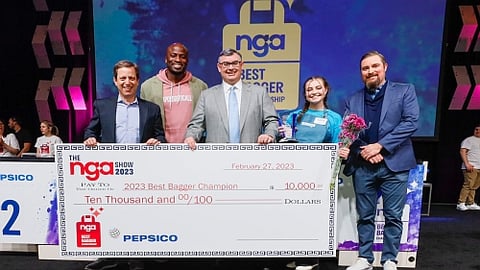NGA Show Recap: Lots to Learn
There was a lot going on at the recent NGA Show, which took place Feb. 26-28 at Caesars Forum, in Las Vegas. Aside from the bustling show floor, attendees – primarily representatives of the retail and wholesale sectors of the independent grocery business, along with suppliers – could benefit from an array of impactful sessions, all of them focusing on the issues of most importance to indies.
Following an opening day kickoff that featured a riveting keynote address from blind athlete Erik Weihenmeyer, in which he discussed dealing with adversity without ever sugarcoating the struggle it takes to succeed, the show’s educational sessions included the following:
- Multicultural Marketing, moderated by Jim Dudlicek, director of communications and external affairs at the Washington, D.C.-based National Grocers Association (NGA), in which the participants discussed their respective approaches to bringing diverse consumers into their stores. Methods include hiring bilingual staffers, providing circulars and social media posts in the native languages of these shoppers, and stocking culturally relevant products. As Rich Wardwell, CEO and president of Los Angeles-based Superior Grocers, noted, retailers must “delve into finding new paths” to reach out to these customers, who are steadily growing in number.
- What Gen Zs Want, sponsored by Kellogg Co. and moderated by Kristin Popp, SVP of Janesville, Wis.-based Woodman’s Food Markets Inc., featuring five female college students who aspire to food industry careers. The students asserted that their priorities for a company where they seek employment are such factors as diversity, transparency, growth opportunities, the ability to think disruptively, and work/life balance, while as consumers, they value an appealing atmosphere, bargains on products, online influencer content and convenience. As both professionals and shoppers, the students placed a high premium on in-person experiences – a stance at odds with the common perception of younger people being more interested in digital encounters.
- Smarter Sourcing at a Time of Higher Costs, hosted by Joe Tarnowski, VP of content and global media at San Francisco-based RangeMe, dealt with how “quick and flexible” retailers can surmount the inflation-fueled obstacle of the title, as well as allocations favoring the bigger players, by looking to local suppliers, forging strong relationships with a trusted wholesalers that can offer greater buying power, and taking advantage of opportunities arising from overproduction, which can result in” tremendous deals,” among other useful strategies. Additionally, once you’ve procured your products and gotten that value price image out there ahead of the competition, don’t be afraid to “promote the heck out of it,” advised Pat Ptacek, owner of Prescott, Wis.-based Ptacek’s IGA, who is known locally and beyond for his entertaining TikTok posts.
- Insights From the Latest “State of Snacking” report, presented by Rick Brindle, soon to retire as VP of industry development from Deerfield, Ill.-based Mondelez, who offered the mind-blowing info that consumers are now snacking more than they’re eating meals, with snacking up to five times daily, while meals clocked in at fewer than two. Brindle also pointed out that snacks were becoming less impulsive buys and more planned purchases; that limited-edition products increase snack purchases; that mindful snacking is on the rise, although indulgence is still important; and that single-use packaging needs to be more eco-friendly to align with consumers’ values.
- The unfortunately timely Active Shooter Prep, introduced by Jon McCormick, president and CEO of Kansas City-based Retail Grocers Association Missouri and Kansas, and featuring the input of a retired FBI special agent and an employment lawyer to discuss the safety and legal issues surrounding a supermarket shooting. The key takeaway is that grocers must be prepared before, during and after such an event through rigorous associate training; thorough background checks; a plan to keep as many employees and customers safe as possible by such means as installing metal detectors, banning weapons where possible, deploying armed security guards, and identifying exits and hiding places in the building; establishing a mechanism whereby workers can safely report their concerns regarding erratic behavior of colleagues that could lead to violence; and dealing with a traumatized workforce and community, as well as any fallout as to what the grocer could have done better or prevented from happening. Sadly, as McCormick noted regarding the probability of a store shooting, “It’s not a matter of if it’s going to happen, but when.”
- Digital Marketing Transformation, hosted by Shawn Tuckett of Tampa, Fla.-based Webstop, which provides these types of solutions for grocers. Participants discussed their own companies’ successes in ventures that included adopting digital circulars, becoming part of a retail media network and capturing the local market through such means as flash sales. Matt Corbin, director of marketing at Pay and Save Inc., a division of Littlefield, Texas-based Lowe’s Market, urged grocers on the fence in regard to an omnichannel overhaul not to delay: “Don’t get over the top of your skis, but go as fast as you can.” Panelists agreed that finding the right tech partner to work with on such an endeavor made all the difference.
That was just a sampling of the sessions on offer during The NGA Show. Those lucky enough to attend the event were able to find enlightening educational content on many of the matters that most affect their businesses, and to bring those learnings back to improve their store operations and, ultimately, better serve their customers. Small wonder that on the show’s opening day, John Ross, CEO of Chicago-based IGA and a passionate advocate for indies, described himself as “optimistic and bullish” about the future of the sector, and wrapped things up on the last day with an exhortation for grocers “to take control of [their] own destiny.” Thanks to the educational sessions at The NGA Show, many of them will be able to do just that – and win.








